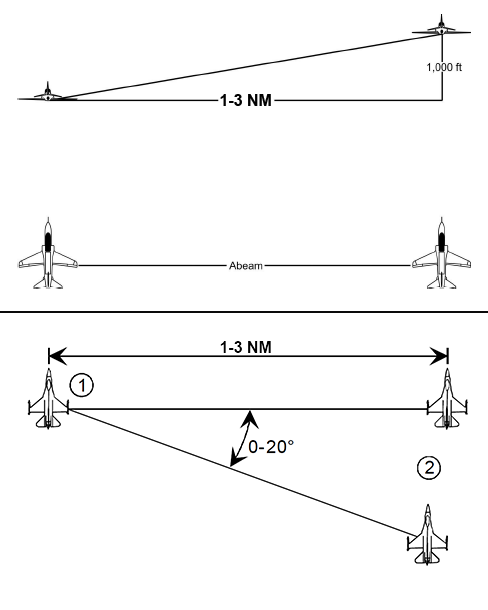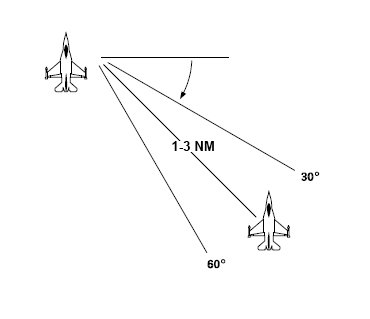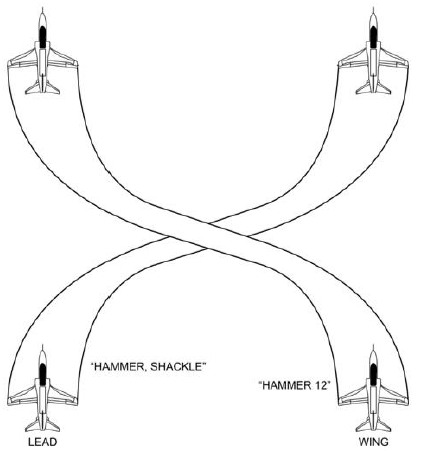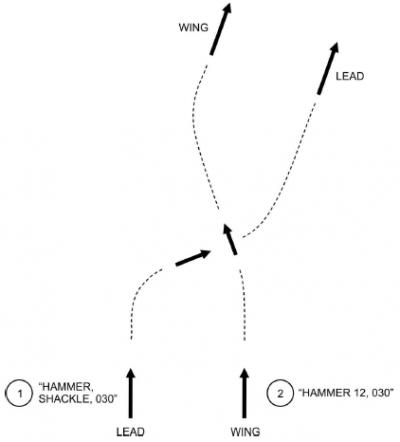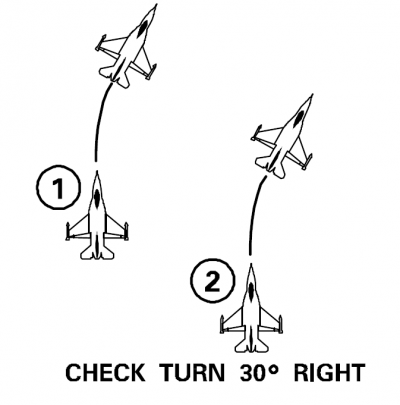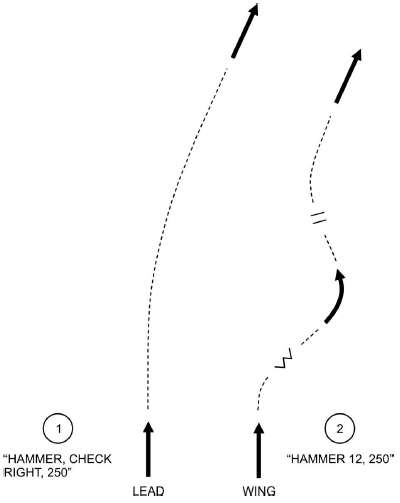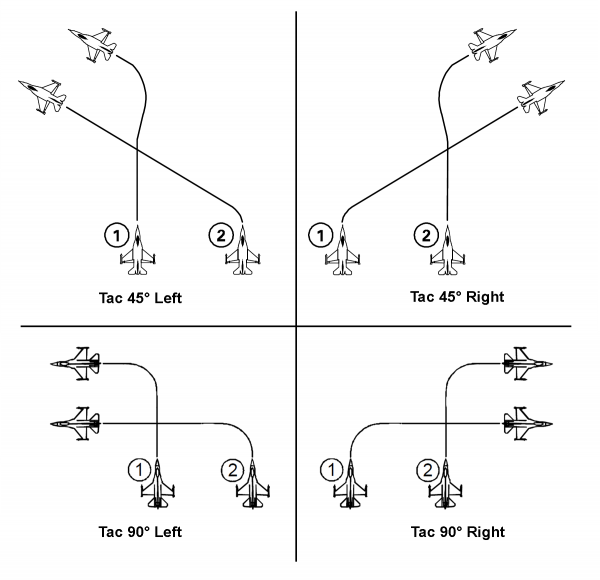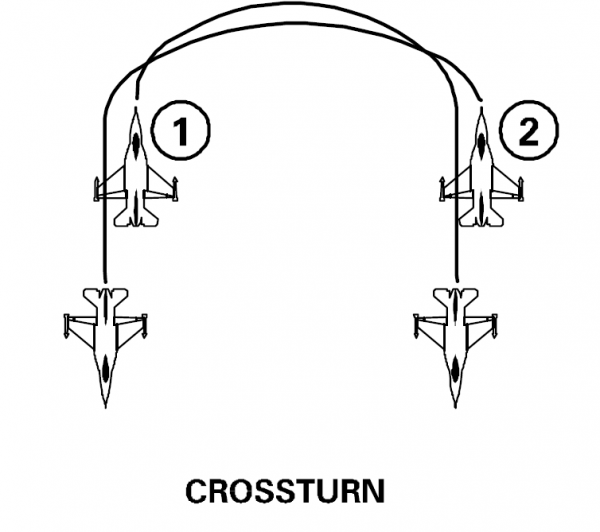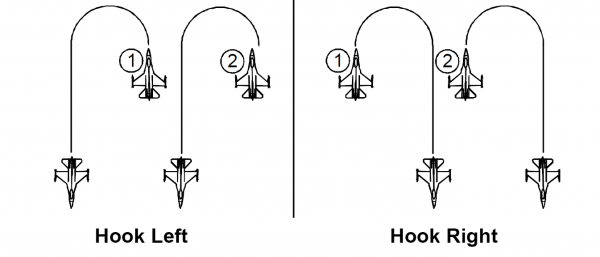Advanced Formations and Movement
Home >> Tactical Guides >> Advanced Formations and Movement
Innehåll
Advanced Formations and Movements
Purpose
The purpose of the formations and the manoeuvres described below are quite simple. They are the mechanisms which one transform a number of aircraft into a more tactically useful unit. Essentially, what these elements provide is the ability to maintain formation geometry during turns and movements. In addition, by having a set of standard procedures and movements, “spread formations” become significantly easier to fly.
Combat Spread formation
The basic formation when not cruising or otherwise requiring close contact between aircraft is the Combat Spread formation. It affords both aircraft freedom of movement and ability to concentrate on tactical tasks, as well as providing other tactical benefits.
It comes in two varieties:
The Line Abreast formation has two (or more) aircraft in a line abeam (up to 20° offset). 1 -3 nm horizontal separation.
The Wedge (Fighting wing) formation has the aircraft in an echelon (30 – 60°). Useful for when you want longitudinal separation between aircraft, such as intercepts.
The aircraft can have the same altitude, or be spread vertically, normally +-1000 ft (300 m) in the defensive, and 3000 ft (1000 m) in the offensive posture.
For the purposes of training, familiarise yourself with the line abreast formation first, as it is simpler geometrically.
Turns
The turns used in all of these examples are standard turns. Each of the aircraft maintain the same angle of bank, which results in the same turn radius for the given airspeed. Normal 45° angle of bank. Steep 60° angle of bank.
During turns, make sure to maintain airspeed! Changing airspeed will cause the turn radius to change, resulting in a worse outcome for the formation geometry at the end of the manoeuvre.
Shackle
When: Situations require lead and wingman to swap places in a formation.
Shackle is a manoeuvre used to reorder the aircraft in a formation, essentially swapping sides between aircraft or elements.
The two aircraft or elements will turn into each other, in a scissor-like motion.
Brevity “Shackle”
Shackles can also be used when making minor course changes (up to 30 degrees)
Check turns
When: Turns up to 30 degrees
Brevity: Check left/ right [heading]
Due to the geometry of the turn, the inner aircraft will fly a shorter flightpath than the outer aircraft, resulting in a change in relative position. This can adressed in two ways.
Either;
Geometrically: The inner aircraft add either a vertical component (climbing and sinking) or S-turns to lengthen the flight path.
Airspeed: The inner aircraft can reduce airspeed by a small amount in order to offset difference.
Tactical turns (Tac-turns)
When: 45 or 90 degree Turns
Brevity: "Tac 45 / 90 Left / Right"
In order not to have inordinately different lengths in flight path, the turn is a delayed turn for the inner aircraft. The tac turn will result in a formation change. For example, the wingman starts the turn on the left, and will end up on the right.
Tac 45. The outer aircraft starts the turn, and when passing the 6 o’clock position of the inner aircraft, the inner aircraft begins it’s turn.
Tac 90. The outer aircraft starts the turn. When their nose is pointed at the inner aircraft, the inner aircraft begins it’s turn.
For training purposes, the outer pilot should report either when passing behind or nose onto the inner pilot. Such as “nose on”, “passing behind”.
Cross turns
When: Turns 180 degrees
Brevity: “Cross turn”
Both aircraft turn towards each other, and will pass over / underneath each other.
Used then reversing course, such as a threat from the front or reaching undesirable airspace. The flight will cover the same area during the retreat as during the approach. Useful flying through threat corridors, and avoiding sideways movement of the formation.
Hook turns
When: 180 Degree turns Both aircraft turn the same way, leading to the entire formation moving one turn radius to left / right. Useful when a sideways movement is desired, such as clearing the way for aircraft behind etc.
